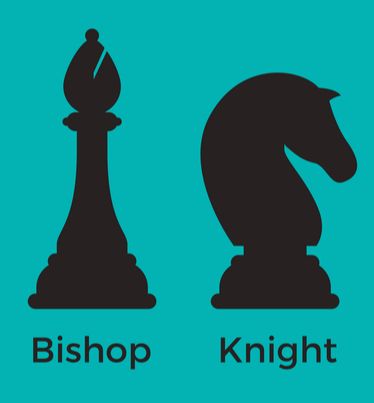
The Eternal Battle: Bishops vs Knights
The Chess.com member dudejan asked:
I always seem to struggle to know where to develop my bishops. For knights the concepts of outposts or placement behind a pawn to double defend certain squares are quite logical for me. But for bishops I don’t seem to have the same understanding. I think this is mainly because at the time when you need to develop the bishop, it isn’t clear which diagonals are going to open up. For instance when playing White, developing the dark-squared bishop to e3, f4 or g5 all seems logical, yet somehow I don’t have a structured way of thinking that will allow me to see which is best.
SILMAN:
Instead of concentrating just on bishops, I’ll also discuss basic knight strategy since both are often chewing each other’s heads off (bishop and knights are kind of like cats and dogs).

In general, the “powers” of bishops and knights are easy to learn:
- A bishop is a long-range piece and a knight isn’t.
- Though a knight can’t leap across the board in a single bound, it can attack (or land on) any square on the board, be it a white square or black. A bishop is stuck forever on whatever color it started on.
Here’s an example of a knight seeking a delicious meal:
LET’S GO A BIT DEEPER.
- Knights are best when they find a hole (a square in enemy territory that can’t be touched by enemy pawns).
- Knights are defensive pieces until they hit the fourth rank (which is quite good), the fifth (as good, or better, than a bishop), and the sixth rank (the ultimate perch). Ideally, an advanced knight (4th-6th ranks) should be on a hole. However, sometime a hole’s not necessary.
Knight On The 4th Rank, Sitting On A Delicious Hole
Knight On The 5th Rank, All Hail The Knight!
Knight On The 6th Rank, Lording Over The Universe
- If there is no hole then the knight might find a nice, advanced square elsewhere that can only be chased away at the cost of some other weakness.
Knight On The f5-Perch
- Bishops are simpler. Just stick it on a clear diagonal, put a superhero cape on its head, and away it goes! Okay, okay, it’s not THAT simple. The bishop might be needed for defensive duty, or it might do more damage on a smaller diagonal. I never said that chess was an easy game!
- Every position has its secrets, and it’s your job to figure out what those secrets are.
The Bishop Roars!
HEY, LET’S GO EVEN DEEPER.
- A bishop is usually inferior to a knight if there are only pawns on one side of the board. Why? Because the bishop’s long-range powers are no longer pertinent, while the knight’s ability to jump on any square is extremely important — it can kick a king, harass or capture a pawn on any color, and move quickly since half the board is no-man’s land.
Here’s a overkill example, but it will highlight the above point:
If there are only pawns on one side of the board but one side has two bishops vs. two knights, then the bishops can be a powerful force since the pair of bishops suddenly can challenge anything on any color
KNIGHTS ARE FLEXIBLE.
Since a knight can roam the board and land on any color it wishes to, it’s more flexible than a bishop. In our example, Fischer puts all his pawns on dark squares, leaving White’s light-squared bishop doing a ghost act. Notice that White’s king can’t penetrate since the c4 and d4 squares are covered. White’s helplessness allows Black to maneuver all over the board. Though White could have drawn, the long grind broke Damjanovic down.
In this second game the knight is used in a completely different manner:
FINALLY, IT’S BISHOP TIME!
Dudejan wants to know where you should put the bishops. In general, it’s fairly simple. I can voice this in two ways: Just let the pawn structure tell you, and have the bishop take aim at a target.
Here’s a quick look:
Here’s a slightly more complicated “where do I put my c8-bishop” choice:
In general, Black has two ways to put that bishop to work (now or eventually): ...Bc8-d7-e8-h5 (getting the bishop outside the pawn chain), or ...b6 and ...Bb7 when an eventual ...c6-c5 will challenge the center while also making Black’s light-squared bishop spit serious flames down the h1-a8 diagonal.
You want more bishop stuff? Okay, let Mr. Fischer show us how to make bishops dance.
Our last game is all about “little things.” White goes after two bishops and more space. Once that’s done, he creates a passed pawn. That’s enough to bring Fine to his knees.



